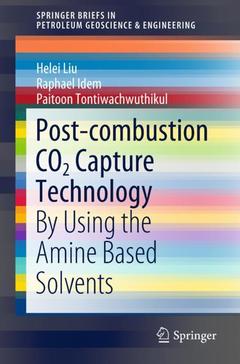Post-combustion CO2 Capture Technology, 1st ed. 2019 By Using the Amine Based Solvents SpringerBriefs in Petroleum Geoscience & Engineering Series

This book presents a comprehensive review of the latest information on all aspects of the post-combustion carbon capture process. It provides designers and operators of amine solvent-based CO2 capture plants with an in-depth understanding of the most up-to-date fundamental chemistry and physics of the CO2 absorption technologies using amine-based reactive solvents. Topics covered include the physical properties, chemical analysis, reaction kinetics, CO2 solubility, and innovative configurations of absorption and stripping columns as well as information on technology applications.
This book also examines the post-build operational issues of corrosion prevention and control, solvent management, solvent stability, solvent recycling and reclaiming, intelligent monitoring and plant control including process automation. In addition, the authors discuss the recent insights into the theoretical basis of plant operation in terms of thermodynamics, transport phenomena, chemical reaction kinetics/engineering, interfacial phenomena, and materials.
The insights provided help engineers, scientists, and decision makers working in academia, industry and government gain a better understanding of post-combustion carbon capture technologies.
Dr Helei Liu is a researcher at the Clean Energy Technologies Research Institute at the Faculty of Engineering and Applied Science, University of Regina (SK, Canada). His research interests mainly involve new technologies for CO2 capture from flue gases from industrial sources, which also involve the development of reaction mechanisms and kinetics for CO2 capture based on new knowledge of CO2–amine interactions. He has published over 30 papers in international journals (AIChE J., Chem. Eng. J., Chem. Eng. Sci., Ind. Eng. Chem. Res., Applied Energy., Int. J. Greenhouse Gas Control, and Fuel) and given more than 10 presentations (key-note, oral and poster) at international conferences (Conference on Greenhouse Gas Control Technologies, annual AIChE meeting, International Conference on Gas–Liquid and Gas–Liquid–Solid Reactor Engineering).
Dr Paitoon Tontiwachwuthikul (known as P.T.) is currently a Full Professor at the Faculty of Engineering and Applied Science at the University of Regina, Canada, where he was the Dean from 1999 to 2013. He obtained his Ph.D. degree in Chemical Engineering from the University of British Columbia, Canada. Dr P.T. is the co-founder of the Clean Energy Technology Research Institute (previously known as the International Test Centre for CO2 Capture – ITC) in Canada. He is one of the main organizers of an international consortium on Low Carbon – Clean Energy Technologies, which includes international research organizations from Canada, Norway, China, Thailand, Turkey and Qatar. He is a key international researcher in the area of advanced CO2 capture and separation from industrial gas streams as well as low-carbon energy development, and has provided technical advice to governments and industries both nationally and internationally. Dr P.T. has played a vital role in the establishment of the Petroleum Technology Research Centre (PTRC), one of the largest petroleum research centers in North America.
Dr Raphael Idem obtained his PBroadens reader’s understanding of available chemical CO2 absorption technologies
Explains how to design, model, and simulate post-combustion carbon capture systems using reactive solvents
Equips readers to manage the solvents through each phase of their use, including proper recycling and reclaiming procedures
Date de parution : 10-2018
Ouvrage de 51 p.
15.5x23.5 cm



